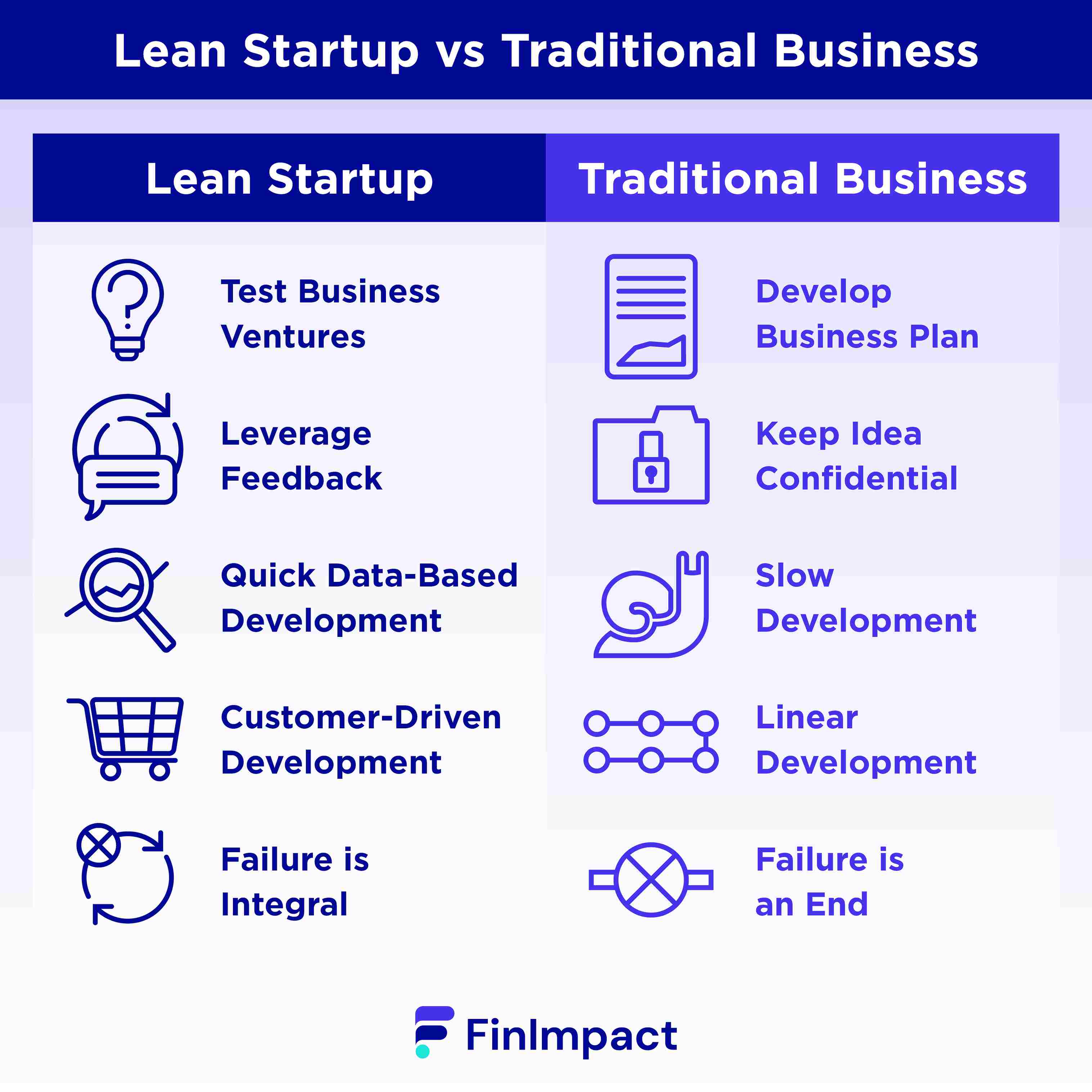
| All content presented here and elsewhere is solely intended for informational purposes only. The reader is required to seek professional counsel before beginning any legal or financial endeavor. |
A Lean Startup is a business model that is based on consumer feedback to develop a product instead of developing a product first and then creating a demand through marketing. This approach is becoming more popular because it is a faster and cheaper way to profitability since you already know there is a demand and long periods of time and large amounts of money does not need to be spent on creating that demand.
Key Points:
- Don’t focus on the funds: A lot of startup ideas don’t require funds upfront. It all depends on the business model you pick and how you develop it.
- Assess the market: Play to your strengths and step into the mind of your target audience. Ask yourself what problem are you solving for your consumers?
- Experiment: When you’re first starting out, put your product or service to the test. Find ways to get customer feedback and see if your startup works long-term, needs fine-tuning, or has to be completely scrapped.
What is a Lean Startup?
A lean startup uses a scientific approach to building and managing a startup with the goal to grow a business with maximum acceleration. The main focus of lean startups is to get rid of wasteful practices early in a business’s development to improve the chances of long-term success.
Lean Startup Methodology
The Lean Startup Method aims to shorten product development cycles and determine whether a proposed business model is viable. Here are the basic approaches used when creating a lean startup:
- Build: This is the first step. You have to understand what the problem is and then develop a version of a product with just enough features to be usable by early customers (MVP).
- Measure: During this stage, you have to find different types of customers to test your product and provide feedback. Gather the data from your MVP and see how it measures up to your initial idea. Improve your MVP with what you learn in this stage, this is agile development.
- Learn: With all the information you've gathered on your MVP, it's now time to gauge how to move forward with your startup idea. Does it make sense to move on to product development, or should you change your idea and repeat the previous stages? Make sure you use your target audience feedback to measure your progress when it comes to customer needs.
History of the Lean Startup
The concept of lean startups began in the early 2000s in Silicon Valley and became a methodology around 2010. This methodology was developed by entrepreneur Eric Ries after he had two business failures. Inspired by the streamlined process of making vehicles with as few resources as possible in Japan during the years immediately following WWII, the methodology seeks to be as efficient as possible without wasting resources.
Lean Startup Benefits
- More productivity: The Lean Startup methodology encourages entrepreneurs to focus on priorities and core tasks. By doing this, development will be faster, which will ultimately boost productivity while saving time.
- Cost Reduction: When you're removing steps and tasks that don't contribute to sustainable development, you save time and boost your profit.
- Customer focused: The data you gather from customers is the key to creating a successful business model that will thrive.
Lean Startup vs Traditional Business

As a general rule of thumb, the Lean Startup approach focuses more on trial and error, while traditional business approaches focus more on following a structured plan. Here are a few key differences between the two:
- Strategy: The lean startup methodology encourages entrepreneurs to test their business ventures and leverage feedback from customers to move forward. Traditional approaches advise business owners to develop a business plan, raise funds, and keep their startup idea secret to anyone beyond investors.
- Speed: The Lean Startup method leverages data to quickly determine a course of action, while traditional business models often take years to develop a product or service confidentially and only then will they offer it to customers.
- Product Development: While traditional approaches prepare the entirety of a product or service for the market in linear fashion, lean startups use customer feedback to test and perfect their business idea.
- Failure: Failure is an integral part of the lean startup process and is taken as a learning experience to develop better offerings and improve products. In contrast, traditional business models often have to fire entire teams or abandon completed projects if they fail.
Examples of Lean Startups
- Dropbox: This file transfer service is well known for using the lean startup method and leveraged it to grow. With over 500 million users worldwide, it started off as a MVP in the form of a 3 minute tutorial showing consumers what Dropbox could do.
- General Electric: Testing prototypes with consumers has been at the heart of GE's MO. Over 40,000 of the company's staff members have been trained in the lean startup methodology, which now helps them develop everything from lightbulbs to fridge doors.
- Google: The lean startup turned unicorn is the default online search engine today. When it first started, its creators Sergey Brin and Larry Page saw flaws in Excite or Yahoo and strived to improve upon their idea to create a reliable, comprehensive, and speedy search engine.
Lean Startup Principles
- Entrepreneurs are everywhere: There are as many kinds of startups as there are entrepreneurs. Just because Google made it as the #1 search engine doesn't mean that's what you have to do too. Find an idea that works for you and take advantage of various gaps in the market to build a successful business.
- Entrepreneurship is about management: The difference between a successful startup and one that fails, often comes down to management. Focusing on continuously learning as well as flexible management will make for a successful lean startup.
- Validated learning: Lean startups have a customer-first approach. They continuously adapt their product or service in relation to the feedback they get from customers and what they learn from experimentation.
- Account for Innovation: You can’t manage what you can’t measure. Lean startups use this key principle as part of their growth strategy. Keeping records of feedback and tests helps business owners to gauge progress that will directly impact the innovation of their product or service.
- Update Regularly: Once the feedback is in, entrepreneurs should update the product/service by incorporating new features or tweaking existing ones to then send it out for evaluation again as soon as possible.
- Conduct A/B Testing: Making two versions of your product/service to customers will give you key insights into how they react to these different possibilities and what the users prefer.
- Track Actionable Metrics: Keeping track of metrics will make the decision-making process clearer for any future changes you have to implement into your product/service.
- Focus on the MVP (Minimum Viable Product): Create a version of a product with just enough features to be usable by early customers. This way, you can avoid wasting excess time and resources while learning about your customers’ needs and expectations.
- Build-Measure-Learn: This is the foundational principle of lean startups. It aims to shorten product development cycles and determine whether a proposed business model is viable.
How to Create a Lean Startup
The steps to creating a lean startup align with build-measure-learn methodology. Here's how you can get started:
- Build Your Business Model: To begin, founders outline their idea on a business model canvas which proposes a solution to an issue that has a gap in the market. They create an MVP that can be used to test out their solution.
- Test Your Idea: Then, founders take their idea and test it on prospective customers with the aim to understand their needs as well as demand. At this stage, the MVP is fine-tuned and goes through experimentation.
- Adopt Agile Development: Once the founders see that their idea has traction and is in demand in the market, they transition into an operational business. At this stage, the startup has functional departments and can invest more of their capital on marketing and sales.
Final Word
The lean startup method is a great approach to business for entrepreneurs who want to start their company with limited funding. By leveraging these principals, you can get ahead of the game quickly without wasting resources. By putting this method into action, you'll be able to build a business that's exciting, and you'll know for certain whether it will succeed by analyzing customer feedback from an early stage.
Many innovative business ideas fail due to lack of funding at the early stage. If you're looking to fund your new business, make sure to explore the best startup business loan options on our list.
